Citroen JUMPER RHD 2011.5 2.G Service Manual
Manufacturer: CITROEN, Model Year: 2011.5, Model line: JUMPER RHD, Model: Citroen JUMPER RHD 2011.5 2.GPages: 184, PDF Size: 4.98 MB
Page 41 of 184
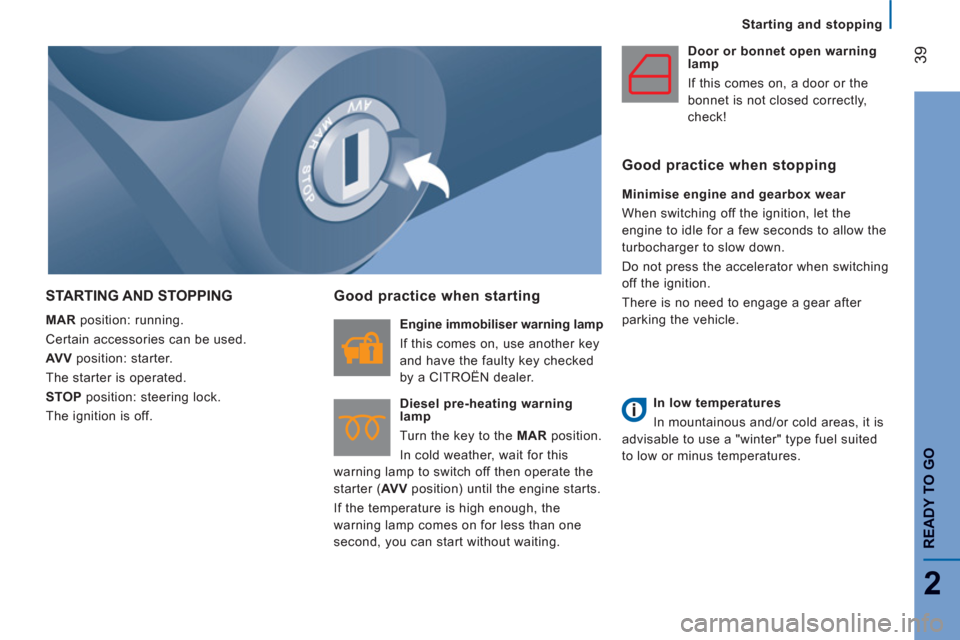
Starting and stopping
39
2
READY TO G
O
STARTING AND STOPPING
MAR
position: running.
Certain accessories can be used.
AV V
position: starter.
The starter is operated.
STOP
position: steering lock.
The ignition is off.
Good practice when starting
Engine immobiliser warning lamp
If this comes on, use another key
and have the faulty key checked
by a CITROËN dealer.
Diesel pre-heating warning
lamp
Turn the key to the MAR
position.
In cold weather, wait for this
warning lamp to switch off then operate the
starter ( AV V
position) until the engine starts.
If the temperature is high enough, the
warning lamp comes on for less than one
second, you can start without waiting.
Door or bonnet open warning
lamp
If this comes on, a door or the
bonnet is not closed correctly,
check!
Good practice when stopping
Minimise engine and gearbox wear
When switching off the ignition, let the
engine to idle for a few seconds to allow the
turbocharger to slow down.
Do not press the accelerator when switching
off the ignition.
There is no need to engage a gear after
parking the vehicle.
In low temperatures
In mountainous and/or cold areas, it is
advisable to use a "winter" type fuel suited
to low or minus temperatures.
Page 42 of 184
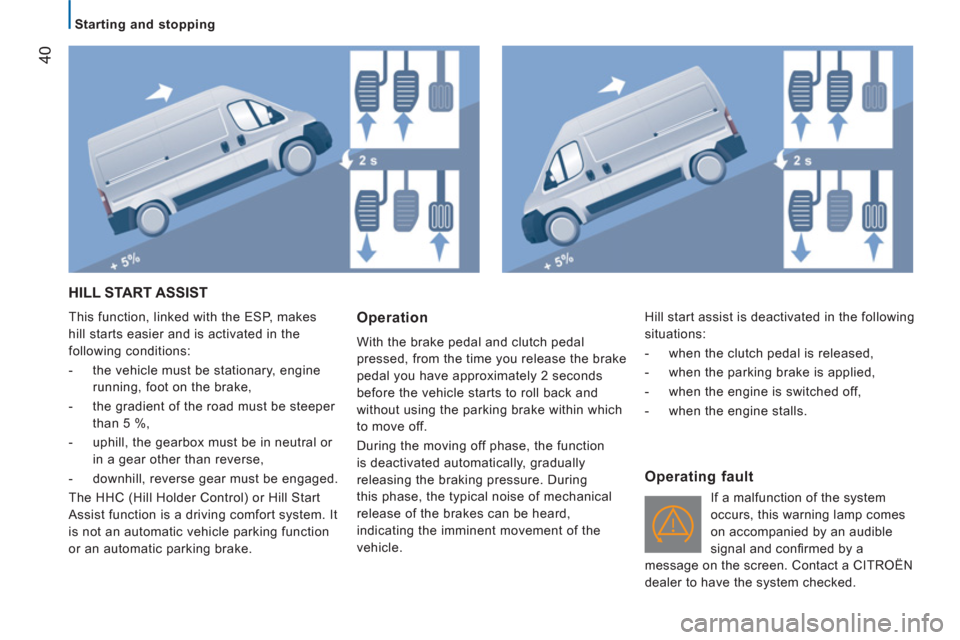
40
Starting and stopping
HILL START ASSIST
This function, linked with the ESP, makes
hill starts easier and is activated in the
following conditions:
- the vehicle must be stationary, engine
running, foot on the brake,
- the gradient of the road must be steeper
than 5 %,
- uphill, the gearbox must be in neutral or
in a gear other than reverse,
- downhill, reverse gear must be engaged.
The HHC (Hill Holder Control) or Hill Start
Assist function is a driving comfort system. It
is not an automatic vehicle parking function
or an automatic parking brake. Operation
With the brake pedal and clutch pedal
pressed, from the time you release the brake
pedal you have approximately 2 seconds
before the vehicle starts to roll back and
without using the parking brake within which
to move off.
During the moving off phase, the function
is deactivated automatically, gradually
releasing the braking pressure. During
this phase, the typical noise of mechanical
release of the brakes can be heard,
indicating the imminent movement of the
vehicle.
Operating fault
If a malfunction of the system
occurs, this warning lamp comes
on accompanied by an audible
signal and confi rmed by a
message on the screen. Contact a CITROËN
dealer to have the system checked. Hill start assist is deactivated in the following
situations:
- when the clutch pedal is released,
- when the parking brake is applied,
- when the engine is switched off,
- when the engine stalls.
Page 43 of 184

41
3
EASE OF USE AND COMFOR
T
Improved comfort
SOUNDPROOFING
Your vehicle benefits from a suspension
which contributes to improving general
comfort.
These developments also contribute to
reducing noise disturbance.
IMPROVED COMFORT
TREATMENT OF THE BODYWORK
LEADING TO ACOUSTIC COMFORT
The underseal under the body, on the body
sills and on the wheel arches considerably
reduces noise and protects the body from
external attack. Your vehicle is treated by cataphoresis,
ensuring perfect protection against
corrosion. The anticorrosion warranty has
a duration of 6 years.
Page 44 of 184
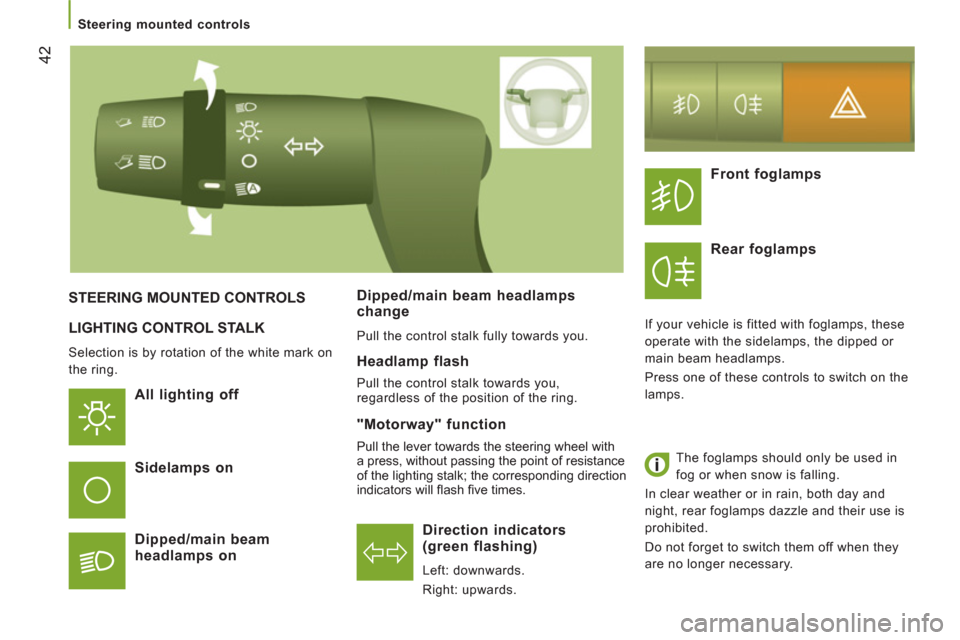
42
Steering mounted controls
LIGHTING CONTROL STALK
Selection is by rotation of the white mark on
the ring.
All lighting off
Direction indicators
(green flashing)
Left: downwards.
Right: upwards.
STEERING MOUNTED CONTROLS
Sidelam
ps on
Di
pped/main beam
headlamps on Dipped
/main beam headlampschange
Pull the control stalk fully towards you.
Headlamp flash
Pull the control stalk towards you,
regardless of the position of the ring.
Front foglamps
Rear fo
glamps
If your vehicle is fitted with foglamps, these
operate with the sidelamps, the dipped or
main beam headlamps.
Press one of these controls to switch on the
lamps.
The foglamps should only be used in
fog or when snow is falling.
In clear weather or in rain, both day and
night, rear foglamps dazzle and their use is
prohibited.
Do not forget to switch them off when they
are no longer necessary.
"Motorway" function
Pull the lever towards the steering wheel with
a press, without passing the point of resistance
of the lighting stalk; the corresponding direction
indicators will fl ash fi ve times.
Page 45 of 184
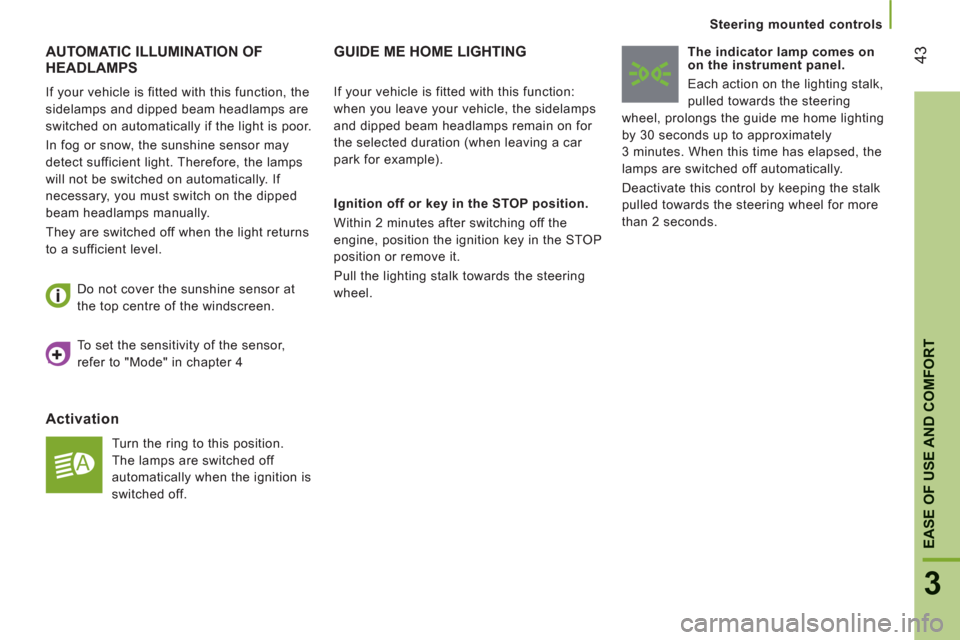
43
3
EASE OF USE AND COMFOR
T
Steering mounted controls
AUTOMATIC ILLUMINATION OF HEADLAMPS
If your vehicle is fitted with this function, the
sidelamps and dipped beam headlamps are
switched on automatically if the light is poor.
In fog or snow, the sunshine sensor may
detect sufficient light. Therefore, the lamps
will not be switched on automatically. If
necessary, you must switch on the dipped
beam headlamps manually.
They are switched off when the light returns
to a sufficient level.
Activation
Turn the ring to this position.
The lamps are switched off
automatically when the ignition is
switched off. Do not cover the sunshine sensor at
the top centre of the windscreen.
GUIDE ME HOME LIGHTING
Ignition off or key in the STOP position.
Within 2 minutes after switching off the
engine, position the ignition key in the STOP
position or remove it.
Pull the lighting stalk towards the steering
wheel.
The indicator lamp comes on
on the instrument panel.
Each action on the lighting stalk,
pulled towards the steering
wheel, prolongs the guide me home lighting
by 30 seconds up to approximately
3 minutes. When this time has elapsed, the
lamps are switched off automatically.
Deactivate this control by keeping the stalk
pulled towards the steering wheel for more
than 2 seconds.
If your vehicle is fitted with this function:
when you leave your vehicle, the sidelamps
and dipped beam headlamps remain on for
the selected duration (when leaving a car
park for example).
To set the sensitivity of the sensor,
refer to "Mode" in chapter 4
Page 46 of 184
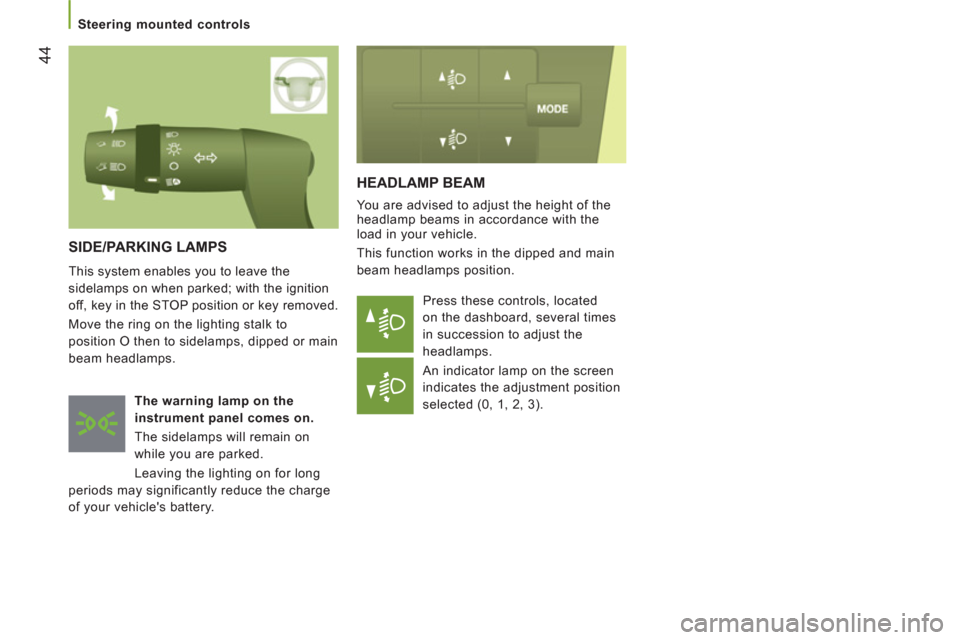
44
Steering mounted controls
HEADLAMP BEAM
You are advised to adjust the height of the
headlamp beams in accordance with the
load in your vehicle.
This function works in the dipped and main
beam headlamps position.
Press these controls, located
on the dashboard, several times
in succession to adjust the
headlamps.
An indicator lamp on the screen
indicates the adjustment position
selected (0, 1, 2, 3).
SIDE/PARKING LAMPS
This system enables you to leave the
sidelamps on when parked; with the ignition
off, key in the STOP position or key removed.
Move the ring on the lighting stalk to
position O then to sidelamps, dipped or main
beam headlamps.
The warning
lamp
on the
instrument panel comes on.
The sidelamps will remain on
while you are parked.
Leaving the lighting on for long
periods may significantly reduce the charge
of your vehicle's battery.
Page 47 of 184
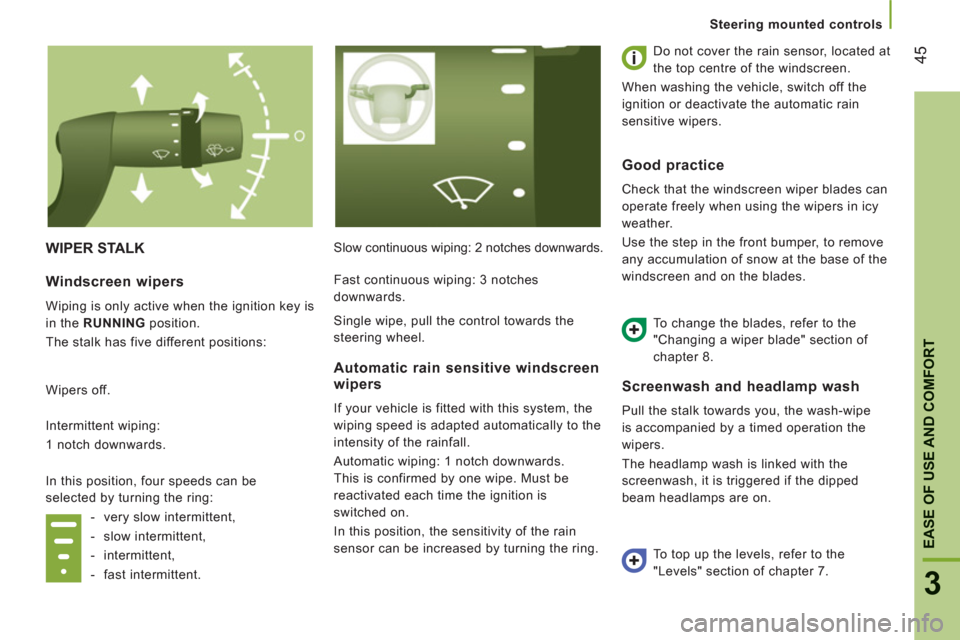
45
3
EASE OF USE AND COMFOR
T
Steering mounted controls
WIPER STALK
Slow continuous wiping: 2 notches downwards. Do not cover the rain sensor, located at
the top centre of the windscreen.
When washing the vehicle, switch off the
ignition or deactivate the automatic rain
sensitive wipers.
Screenwash
and headlamp wash
Pull the stalk towards you, the wash-wipe
is accompanied by a timed operation the
wipers.
The headlamp wash is linked with the
screenwash, it is triggered if the dipped
beam headlamps are on.
Windscreen wipers
Wiping is only active when the ignition key is
in the RUNNING
position.
The stalk has five different positions:
Wipers off.
Intermittent wiping:
1 notch downwards.
In this position, four speeds can be
selected by turning the ring:
- very slow intermittent,
- slow intermittent,
- intermittent,
- fast intermittent.
Automatic rain sensitive windscreen
wipers
If your vehicle is fitted with this system, the
wiping speed is adapted automatically to the
intensity of the rainfall.
Automatic wiping: 1 notch downwards.
This is confirmed by one wipe. Must be
reactivated each time the ignition is
switched on.
In this position, the sensitivity of the rain
sensor can be increased by turning the ring.
Good practice
Check that the windscreen wiper blades can
operate freely when using the wipers in icy
weather.
Use the step in the front bumper, to remove
any accumulation of snow at the base of the
windscreen and on the blades.
To change the blades, refer to the
"Changing a wiper blade" section of
chapter 8.
To top up the levels, refer to the
"Levels" section of chapter 7. Fast continuous wiping: 3 notches
downwards.
Single wipe, pull the control towards the
steering wheel.
Page 48 of 184
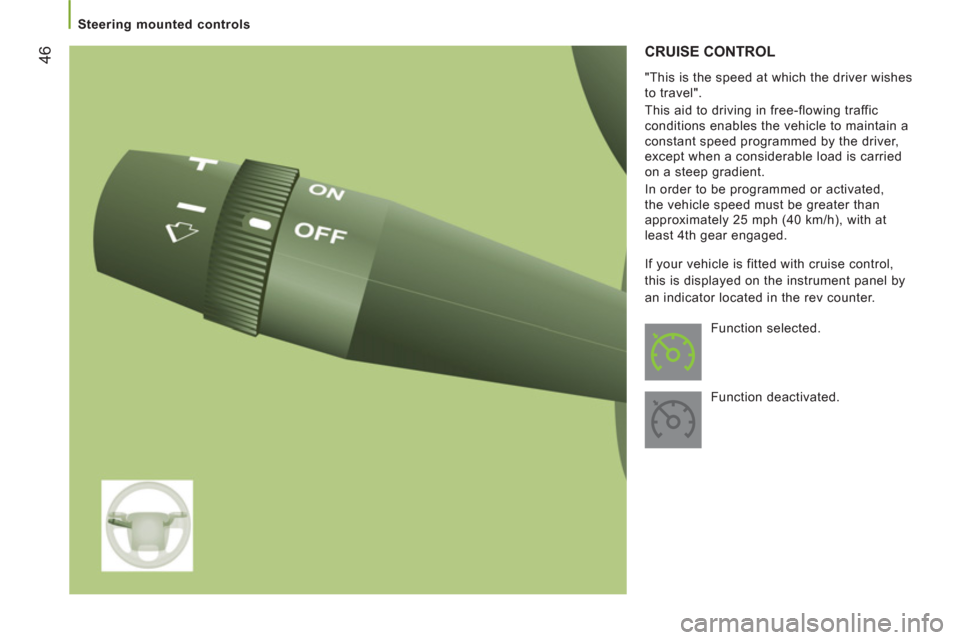
46
Steering mounted controls
CRUISE CONTROL
"This is the speed at which the driver wishes
to travel".
This aid to driving in free-flowing traffic
conditions enables the vehicle to maintain a
constant speed programmed by the driver,
except when a considerable load is carried
on a steep gradient.
In order to be programmed or activated,
the vehicle speed must be greater than
approximately 25 mph (40 km/h), with at
least 4th gear engaged.
Function selected.
Function deactivated. If your vehicle is fitted with cruise control,
this is displayed on the instrument panel by
an indicator located in the rev counter.
Page 49 of 184
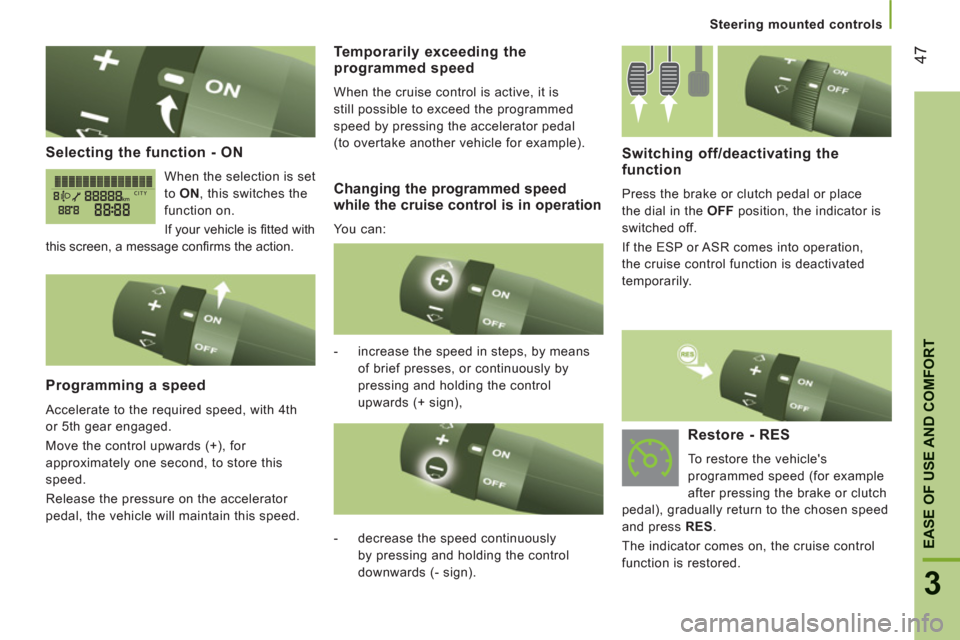
47
3
EASE OF USE AND COMFOR
T
Steering mounted controls
Selecting the function - ON
When the selection is set
to ON
, this switches the
function on.
If your vehicle is fi tted with
this screen, a message confi rms the action.
Programming a speed
Accelerate to the required speed, with 4th
or 5th gear engaged.
Move the control upwards (+), for
approximately one second, to store this
speed.
Release the pressure on the accelerator
pedal, the vehicle will maintain this speed.
Switching off/deactivating the function
Press the brake or clutch pedal or place
the dial in the OFF
position, the indicator is
switched off.
If the ESP or ASR comes into operation,
the cruise control function is deactivated
temporarily.
- increase the speed in steps, by means
of brief presses, or continuously by
pressing and holding the control
upwards (+ sign),
Temporarily exceeding theprogrammed speed
When the cruise control is active, it is
still possible to exceed the programmed
speed by pressing the accelerator pedal
(to overtake another vehicle for example).
- decrease the speed continuously
by pressing and holding the control
downwards (- sign).
Restore - RES
To restore the vehicle's
programmed speed (for example
after pressing the brake or clutch
pedal), gradually return to the chosen speed
and press RES
.
The indicator comes on, the cruise control
function is restored.
Changing the programmed speed
while the cruise control is in operation
You can:
Page 50 of 184
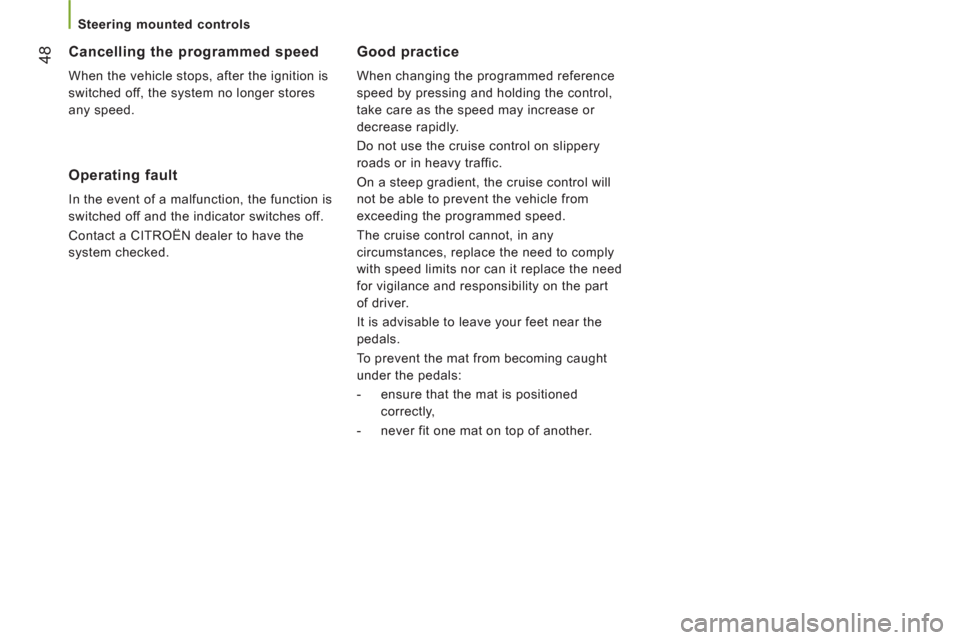
48
Steering mounted controls
Good practice
When changing the programmed reference
speed by pressing and holding the control,
take care as the speed may increase or
decrease rapidly.
Do not use the cruise control on slippery
roads or in heavy traffic.
On a steep gradient, the cruise control will
not be able to prevent the vehicle from
exceeding the programmed speed.
The cruise control cannot, in any
circumstances, replace the need to comply
with speed limits nor can it replace the need
for vigilance and responsibility on the part
of driver.
It is advisable to leave your feet near the
pedals.
To prevent the mat from becoming caught
under the pedals:
- ensure that the mat is positioned
correctly,
- never fit one mat on top of another.
Cancelling the programmed speed
When the vehicle stops, after the ignition is
switched off, the system no longer stores
any speed.
Operating fault
In the event of a malfunction, the function is
switched off and the indicator switches off.
Contact a CITROËN dealer to have the
system checked.